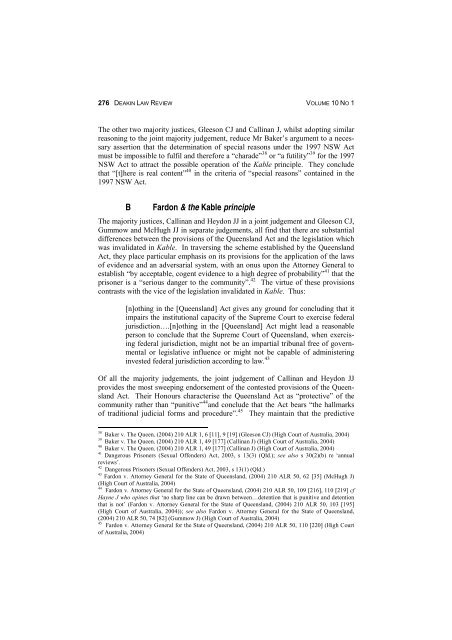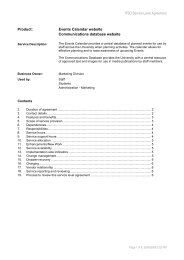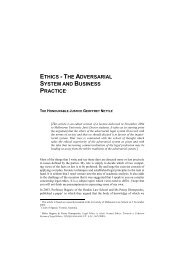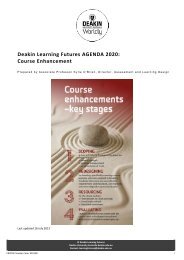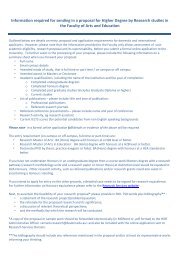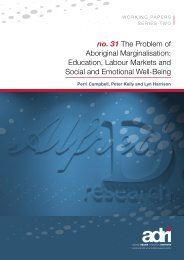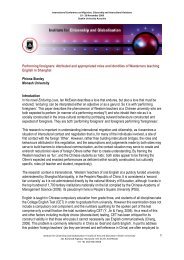baker v the queen fardon v attorney general for ... - Deakin University
baker v the queen fardon v attorney general for ... - Deakin University
baker v the queen fardon v attorney general for ... - Deakin University
You also want an ePaper? Increase the reach of your titles
YUMPU automatically turns print PDFs into web optimized ePapers that Google loves.
276 DEAKIN LAW REVIEW VOLUME 10 NO 1<br />
The o<strong>the</strong>r two majority justices, Gleeson CJ and Callinan J, whilst adopting similar<br />
reasoning to <strong>the</strong> joint majority judgement, reduce Mr Baker’s argument to a necessary<br />
assertion that <strong>the</strong> determination of special reasons under <strong>the</strong> 1997 NSW Act<br />
must be impossible to fulfil and <strong>the</strong>re<strong>for</strong>e a “charade” 38 or “a futility” 39 <strong>for</strong> <strong>the</strong> 1997<br />
NSW Act to attract <strong>the</strong> possible operation of <strong>the</strong> Kable principle. They conclude<br />
that “[t]here is real content” 40 in <strong>the</strong> criteria of “special reasons” contained in <strong>the</strong><br />
1997 NSW Act.<br />
B<br />
Fardon & <strong>the</strong> Kable principle<br />
The majority justices, Callinan and Heydon JJ in a joint judgement and Gleeson CJ,<br />
Gummow and McHugh JJ in separate judgements, all find that <strong>the</strong>re are substantial<br />
differences between <strong>the</strong> provisions of <strong>the</strong> Queensland Act and <strong>the</strong> legislation which<br />
was invalidated in Kable. In traversing <strong>the</strong> scheme established by <strong>the</strong> Queensland<br />
Act, <strong>the</strong>y place particular emphasis on its provisions <strong>for</strong> <strong>the</strong> application of <strong>the</strong> laws<br />
of evidence and an adversarial system, with an onus upon <strong>the</strong> Attorney General to<br />
establish “by acceptable, cogent evidence to a high degree of probability” 41 that <strong>the</strong><br />
prisoner is a “serious danger to <strong>the</strong> community”. 42 The virtue of <strong>the</strong>se provisions<br />
contrasts with <strong>the</strong> vice of <strong>the</strong> legislation invalidated in Kable. Thus:<br />
[n]othing in <strong>the</strong> [Queensland] Act gives any ground <strong>for</strong> concluding that it<br />
impairs <strong>the</strong> institutional capacity of <strong>the</strong> Supreme Court to exercise federal<br />
jurisdiction….[n]othing in <strong>the</strong> [Queensland] Act might lead a reasonable<br />
person to conclude that <strong>the</strong> Supreme Court of Queensland, when exercising<br />
federal jurisdiction, might not be an impartial tribunal free of governmental<br />
or legislative influence or might not be capable of administering<br />
invested federal jurisdiction according to law. 43<br />
Of all <strong>the</strong> majority judgements, <strong>the</strong> joint judgement of Callinan and Heydon JJ<br />
provides <strong>the</strong> most sweeping endorsement of <strong>the</strong> contested provisions of <strong>the</strong> Queensland<br />
Act. Their Honours characterise <strong>the</strong> Queensland Act as “protective” of <strong>the</strong><br />
community ra<strong>the</strong>r than “punitive” 44 and conclude that <strong>the</strong> Act bears “<strong>the</strong> hallmarks<br />
of traditional judicial <strong>for</strong>ms and procedure”. 45 They maintain that <strong>the</strong> predictive<br />
38 Baker v. The Queen, (2004) 210 ALR 1, 6 [11], 9 [19] (Gleeson CJ) (High Court of Australia, 2004)<br />
39 Baker v. The Queen, (2004) 210 ALR 1, 49 [177] (Callinan J) (High Court of Australia, 2004)<br />
40 Baker v. The Queen, (2004) 210 ALR 1, 49 [177] (Callinan J) (High Court of Australia, 2004)<br />
41 Dangerous Prisoners (Sexual Offenders) Act, 2003, s 13(3) (Qld.); see also s 30(2)(b) re ‘annual<br />
reviews’.<br />
42 Dangerous Prisoners (Sexual Offenders) Act, 2003, s 13(1) (Qld.)<br />
43 Fardon v. Attorney General <strong>for</strong> <strong>the</strong> State of Queensland, (2004) 210 ALR 50, 62 [35] (McHugh J)<br />
(High Court of Australia, 2004)<br />
44 Fardon v. Attorney General <strong>for</strong> <strong>the</strong> State of Queensland, (2004) 210 ALR 50, 109 [216], 110 [219] cf<br />
Hayne J who opines that ‘no sharp line can be drawn between…detention that is punitive and detention<br />
that is not’ (Fardon v. Attorney General <strong>for</strong> <strong>the</strong> State of Queensland, (2004) 210 ALR 50, 103 [195]<br />
(High Court of Australia, 2004)); see also Fardon v. Attorney General <strong>for</strong> <strong>the</strong> State of Queensland,<br />
(2004) 210 ALR 50, 74 [82] (Gummow J) (High Court of Australia, 2004)<br />
45<br />
Fardon v. Attorney General <strong>for</strong> <strong>the</strong> State of Queensland, (2004) 210 ALR 50, 110 [220] (High Court<br />
of Australia, 2004)


